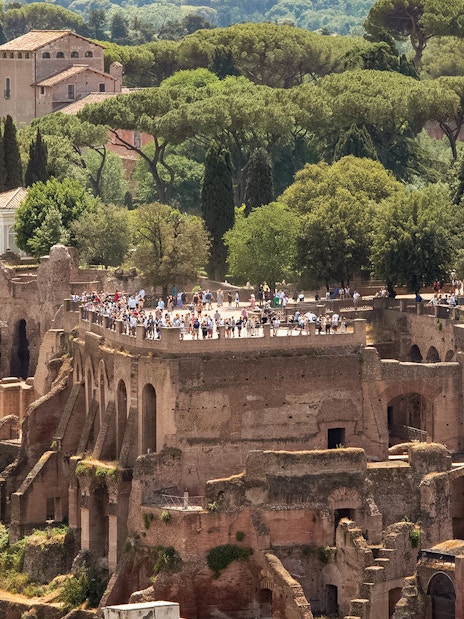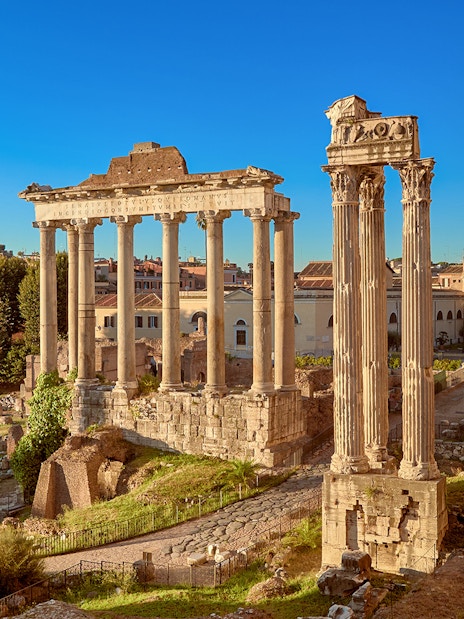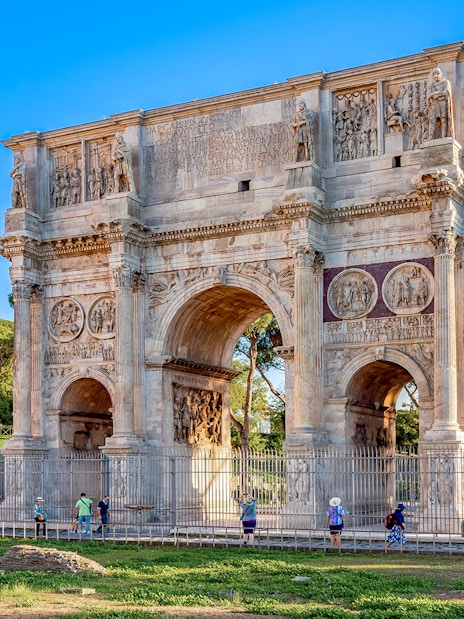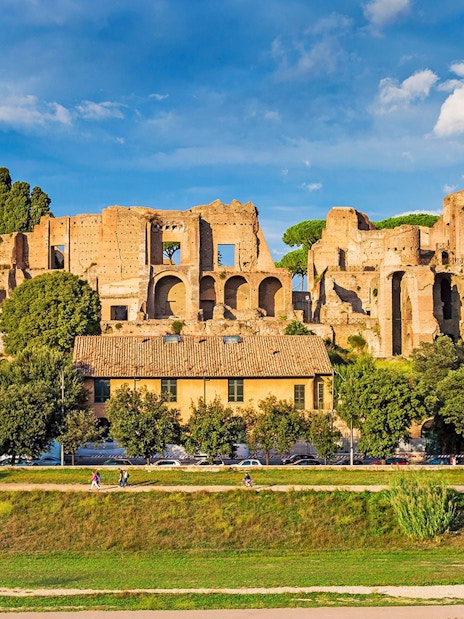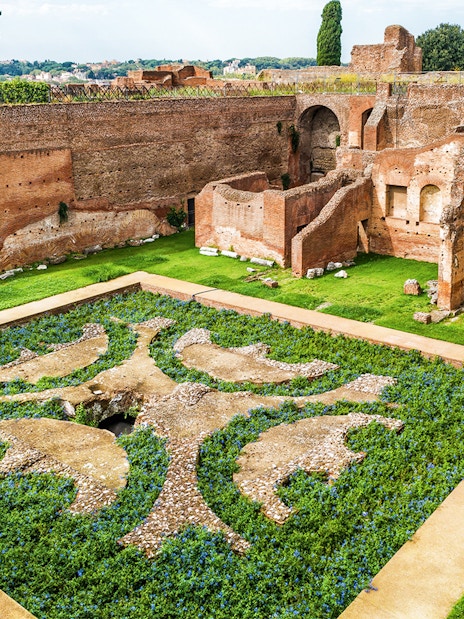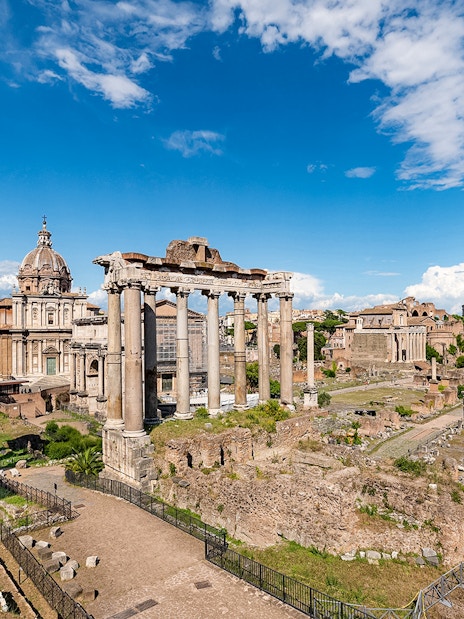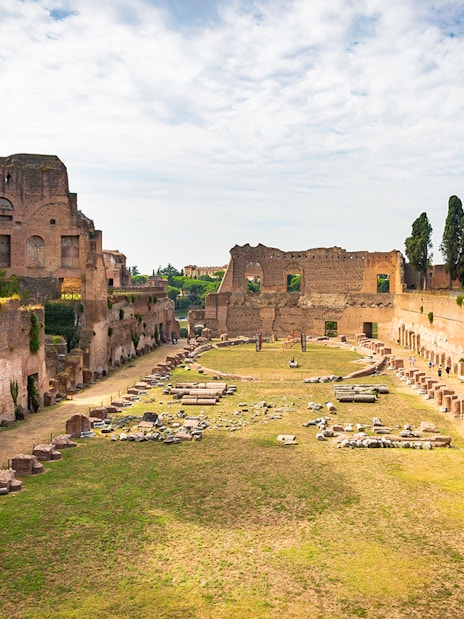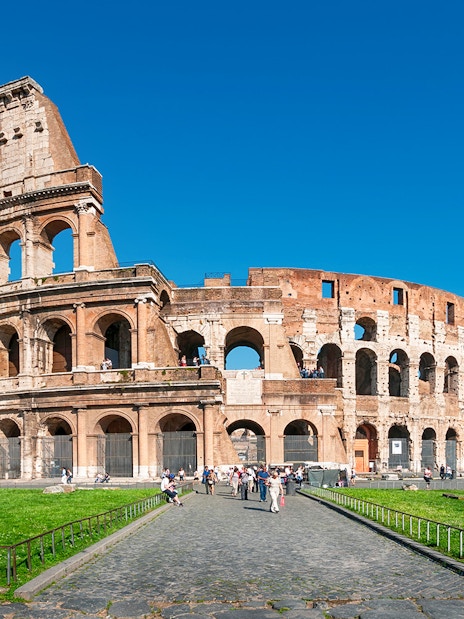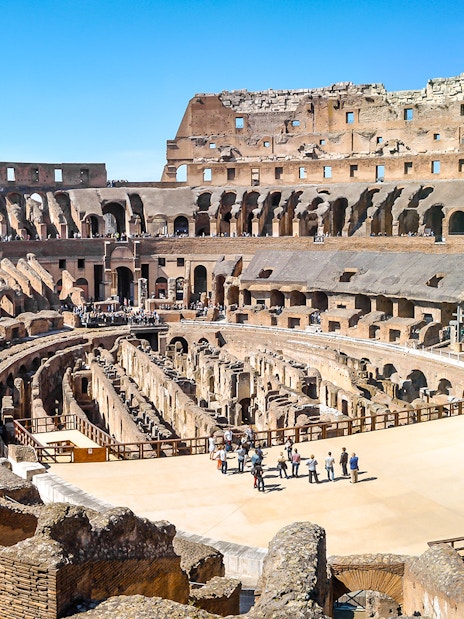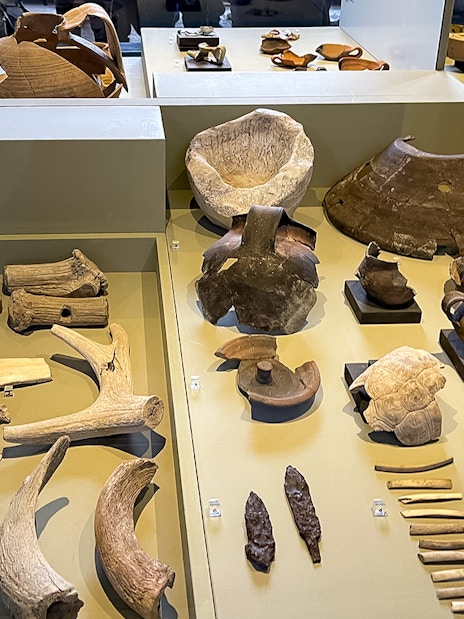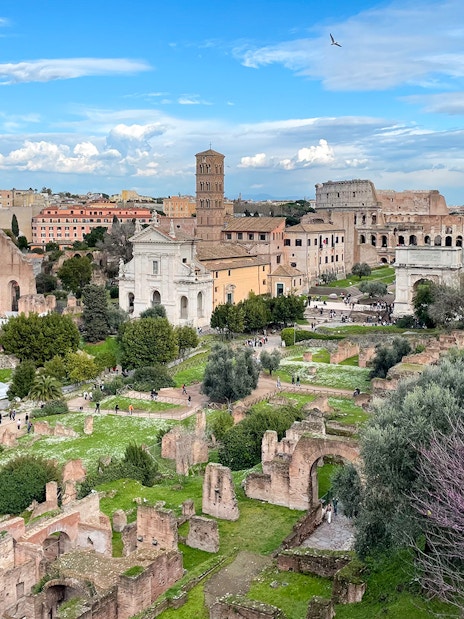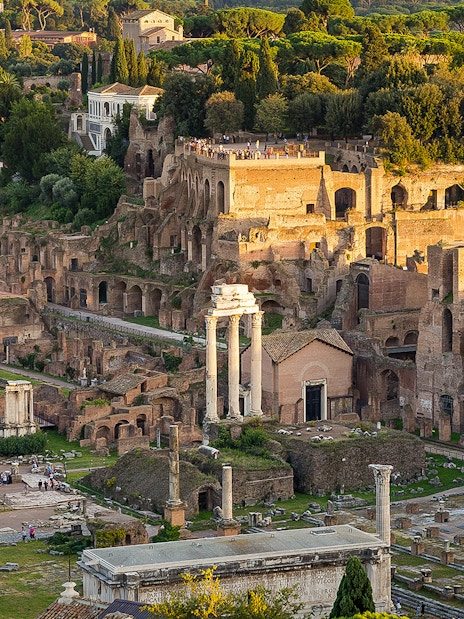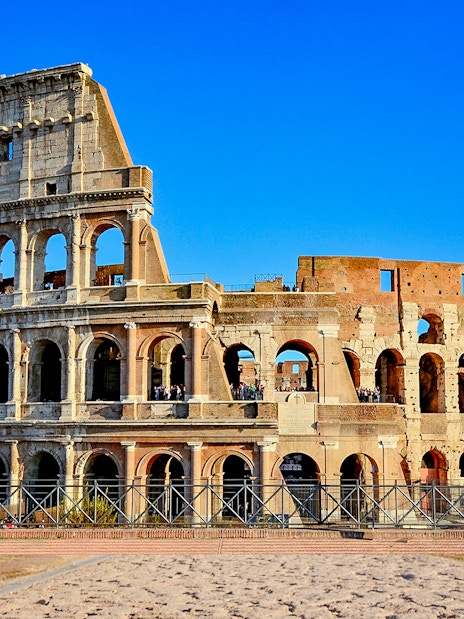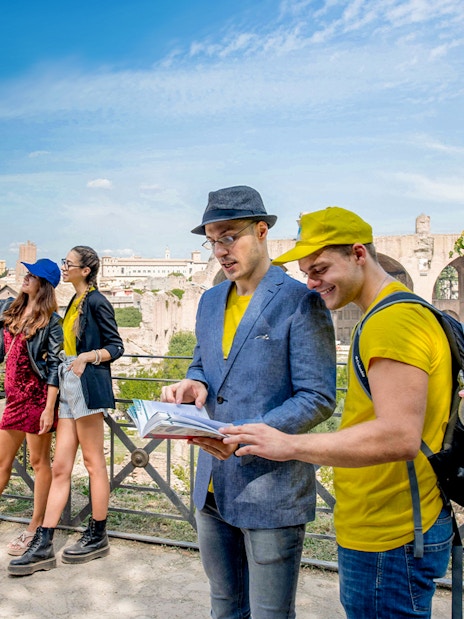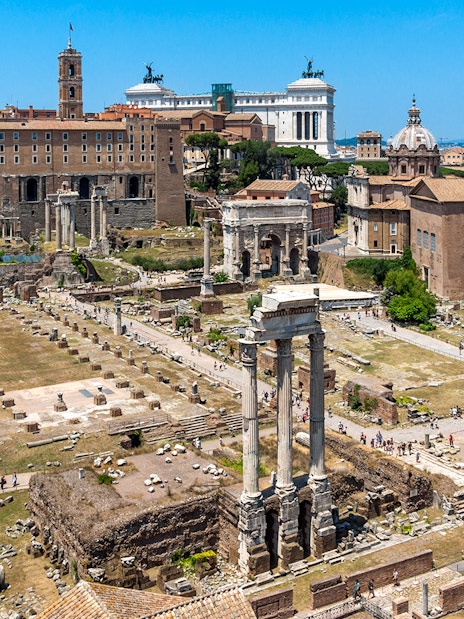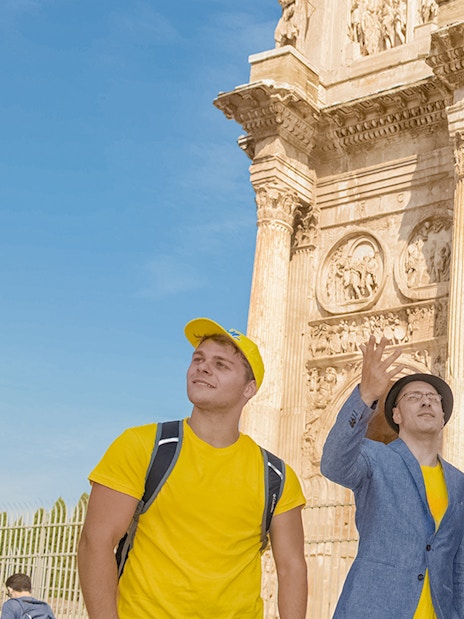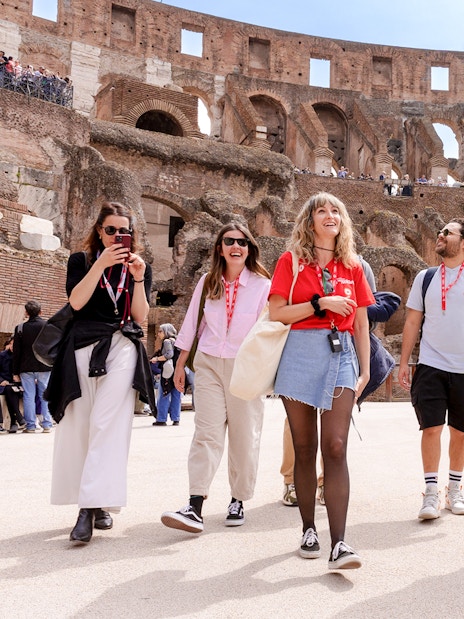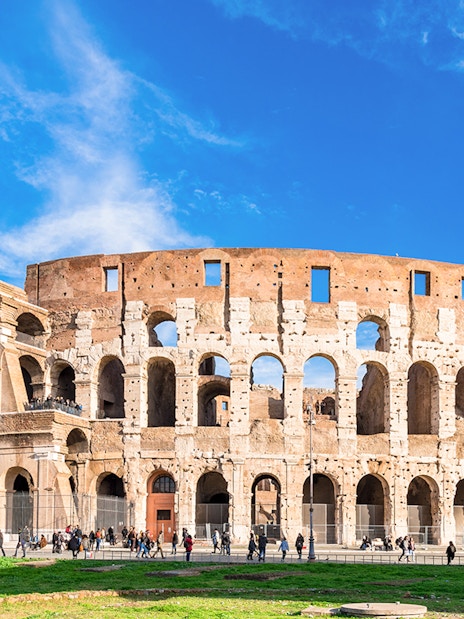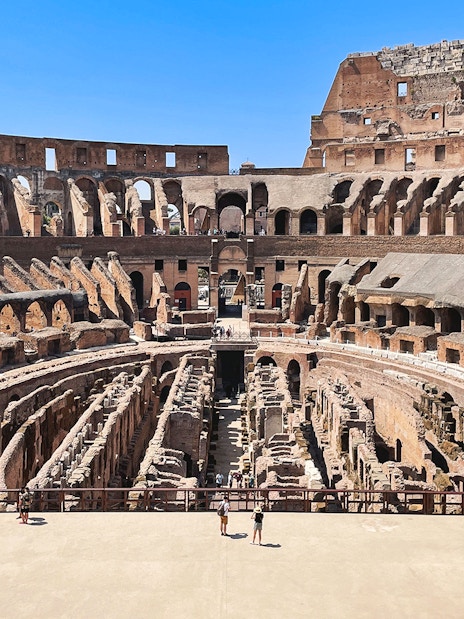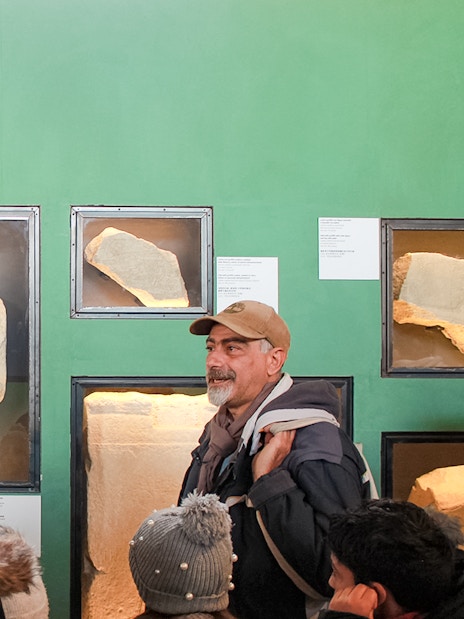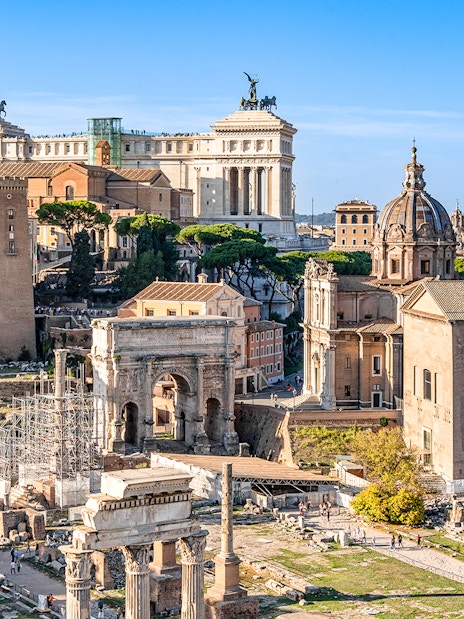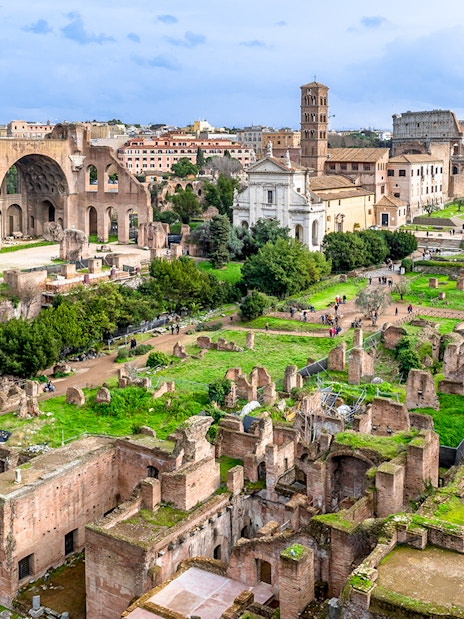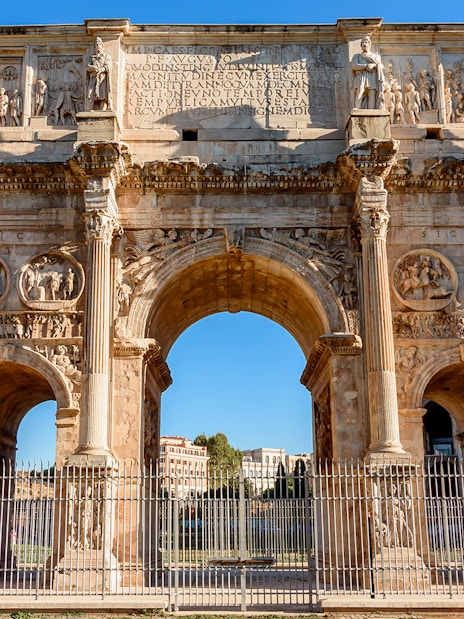- Colosseum
- Vatican Museums
- St. Peter's Basilica
- Castel Sant Angelo
- Rome Pantheon
- Roman Catacombs Tour
- Borghese Gallery
- Bioparco Rome
- Big Bus Rome Hop-on Hop-off Tours
- Palazzo Barberini
- Musei Capitolini
- Leonardo da Vinci Museum
- Trevi Fountain Tours
- Altare della Patria
- Rome Underground Tours
- Mamertine Prison
- Santa Maria Maggiore Basilica
Palatine Hill Tickets and Tours
Headout is an authorized and trusted partner of the venue, offering curated experiences to enjoy this attraction. This is not the venue's website.

Unlock rare access to SUPER Sites—seven exceptional locations within the Colosseum Archaeological Park, typically closed to regular visitors.
- Everything you get: Step inside restricted sites like Curia Julia, where Roman senators met, the House of Augustus, home of Rome’s first emperor, and Santa Maria Antiqua, the oldest Christian monument in the Forum. Enjoy multimedia exhibits and visit the Roman Forum, Palatine Hill, and Imperial Fora.
- Note: This pass does not include entry to the Colosseum.
- Why choose this? Most visitors only see the basics—this pass takes you deeper. Explore sites closed to regular ticket holders, including ancient palaces, temples, and hidden monuments. Perfect for history lovers seeking a rare journey through Rome’s past.
Unlock rare access to SUPER Sites—seven exceptional locations within the Colosseum Archaeological Park, typically closed to regular visitors.
- Everything you get: Step inside restricted sites like Curia Julia, where Roman senators met, the House of Augustus, home of Rome’s first emperor, and Santa Maria Antiqua, the oldest Christian monument in the Forum. Enjoy multimedia exhibits and visit the Roman Forum, Palatine Hill, and Imperial Fora.
- Note: This pass does not include entry to the Colosseum.
- Why choose this? Most visitors only see the basics—this pass takes you deeper. Explore sites closed to regular ticket holders, including ancient palaces, temples, and hidden monuments. Perfect for history lovers seeking a rare journey through Rome’s past.
Inclusions
- Entry to the Roman Forum, Palatine Hill, & Imperial Fora
- Access to SUPER sites: Palatine Museum, Domus Tiberiana, House of Livia, & more.
- Admission to ongoing exhibitions at select sites
- Pass valid for one day
- Full list of attractions & multimedia visit timings here
Exclusions
- Entry to the Colosseum
- Access to the SUPER sites is restricted, as they preserve valuable paintings that might be affected by excessive crowding. You can access them from 9:30am until 1 hour before closing time.
- The passage from the Archaeological Park of the Colosseum to the area of the Imperial Fora is open every day from 9am to 3:15pm.
- Please note that this pass only covers sites in the Archaeological Park (Forums & Palatine Hill), and does not include access to the Colosseum.
- The House of Livia is partially wheelchair accessible, while the House of Augustus and Domus Tiberiana are not accessible by wheelchair.
- Your ticket is valid for one day after being stamped at the entrance.
- It does not require a time reservation and can be used on any day within a month of purchase.
- See the full list of attractions, entrances, and multimedia visit timings here
- These tickets can't be cancelled. However, you can use them any time until 31 December, 2025.
- These tickets are valid until 31 December, 2025.
Reserved entry to the Colosseum at your selected time with the flexibility to explore the Roman Forum and Palatine Hill within 24 hours.
- Everything you get: Enter at your selected time and explore the seating rows where Romans watched battles unfold. Visit the on-site museum on Level 2, displaying artifacts from the Colosseum’s past. Head on to the Roman Forum & Palatine Hill within 24 hours, uncovering ruins of temples, markets, and palaces.
- Why choose this? Most tickets require you to visit all three sites in one go—this one doesn’t. Enter the Colosseum at your selected time, then explore the Roman Forum & Palatine Hill anytime within the next 24 hours. No rush!
- Upgrades: Choose an audio guide for expert insights that accompany you on your phone, watch an immersive multimedia video to experience Ancient Rome before stepping into the amphitheater, or take advantage of an English guidebook to uncover hidden stories as you explore.
- Upgrade to include a visit of the Arena Floor, where gladiators once fought under the roar of the crowd, or explore Mamertine Prison, where history’s most infamous prisoners were held.
Reserved entry to the Colosseum at your selected time with the flexibility to explore the Roman Forum and Palatine Hill within 24 hours.
- Everything you get: Enter at your selected time and explore the seating rows where Romans watched battles unfold. Visit the on-site museum on Level 2, displaying artifacts from the Colosseum’s past. Head on to the Roman Forum & Palatine Hill within 24 hours, uncovering ruins of temples, markets, and palaces.
- Why choose this? Most tickets require you to visit all three sites in one go—this one doesn’t. Enter the Colosseum at your selected time, then explore the Roman Forum & Palatine Hill anytime within the next 24 hours. No rush!
- Upgrades: Choose an audio guide for expert insights that accompany you on your phone, watch an immersive multimedia video to experience Ancient Rome before stepping into the amphitheater, or take advantage of an English guidebook to uncover hidden stories as you explore.
- Upgrade to include a visit of the Arena Floor, where gladiators once fought under the roar of the crowd, or explore Mamertine Prison, where history’s most infamous prisoners were held.
Inclusions
- Timed entry to the Colosseum
- Access tier 1 & 2 and Museum
- Access to Palatine Hill & Roman Forum
- Special access to the Colosseum Arena (as per option selected)
- Audio guide in English, Spanish, French, German, Polish, Italian & Chinese (as per option selected)
- Guidebook (as per option selected)
- Multimedia video (as per option selected)
- Headsets
Exclusions
- Live guide
- Access to the Colosseum underground or upper floors
- Names are mandatory for Colosseum bookings. Double-check the names at checkout for a hassle-free entry. Be sure to bring a valid Photo ID with you to gain entry.
- Please note that timed priority entry is only available at the Colosseum, but the tickets for the Forum and Palatine will remain valid for an additional 24 hours after the Colosseum entry time selected during booking.
- Note that there are 2 entrances: one for the Colosseum, and another for the Roman Forum & Palatine Hill (combined). You may enter each entrance ONLY ONCE and not re-enter.
- The security check can take 30 mins or more. To make the process quicker, please insert any object (including mobile phone) in the bag/backpack or in the tray to be included in the X-ray.
- Going for the audio guide? Simply ensure that the guides are downloaded on the Headout app before your visit. It’s super simple to use, and you get offline access with an easy language-switching feature. Just make sure your phone is fully charged and don’t forget to bring your favorite headphones!
- These tickets can't be cancelled or rescheduled.
Make your once-in-a-lifetime Colosseum visit truly unforgettable with expert guides who bring its legendary history to life.
- Everything you get: Skip the long lines with timed entry and explore the Colosseum’s seating rows along Level 1 and 2 as well as the museum with an expert guide. Then, walk through the Roman Forum’s ancient markets and temples before climbing Palatine Hill for stunning city views.
- Why choose this? A deeper dive into ancient Rome—expert storytelling, priority access, and an immersive journey through its most iconic landmarks.
- Upgrade: Choose a small-group tour—fewer guests mean closer interactions with your guide, better photo opportunities, and a more personalized experience.
Make your once-in-a-lifetime Colosseum visit truly unforgettable with expert guides who bring its legendary history to life.
- Everything you get: Skip the long lines with timed entry and explore the Colosseum’s seating rows along Level 1 and 2 as well as the museum with an expert guide. Then, walk through the Roman Forum’s ancient markets and temples before climbing Palatine Hill for stunning city views.
- Why choose this? A deeper dive into ancient Rome—expert storytelling, priority access, and an immersive journey through its most iconic landmarks.
- Upgrade: Choose a small-group tour—fewer guests mean closer interactions with your guide, better photo opportunities, and a more personalized experience.
Inclusions
- Guided tour of the Colosseum, Palatine Hill, & Roman Forum
- English, Spanish, French, Portuguese, Italian or German speaking guide (as per option selected)
- Small group of 15 people (as per option selected)
- Access to Colosseum tier 1 & 2 and Museum
- Access to Palatine Hill & Roman Forum
- Headsets
Exclusions
- Arena access
- Access to Underground and upper floors
- Tip: The Colosseum tours involve lots of climbing steps and walking. We recommend wearing comfortable shoes to prevent fatigue!
- As there is no timed entrance to the Palatine and Forum, it is not possible to skip the lines. Please expect a delay when entering these sites.
- The experience is not accessible for wheelchair users, pram/stroller users baby carriages, and people with mobility issues. Names are mandatory for Colosseum bookings. Double-check the names at checkout for hassle-free entry. Be sure to bring a valid photo ID with you to gain entry.
- Just a heads-up: the order of the tour might change, so it's a good idea to check for updates before your visit.
- These tickets can't be cancelled or rescheduled.
Elevate your Colosseum visit with an expert-led tour and exclusive Arena Floor access—walk where gladiators fought.
- Everything you get: Skip the wait with timed entry and follow your expert guide through the seating rows as well as the museum displaying historic artifacts on level 2. Step onto the exclusive Arena Floor, where gladiators fought for survival, before exploring the Roman Forum and Palatine Hill.
- Why choose this? Most tours don't include the Arena Floor—this one takes you onto it. Walk where gladiators fought and experience the Colosseum like never before with an expert guide who brings history to life.
- Upgrade: Choose between a small group tour (15 guests) for a more intimate, interactive experience or a larger group tour (25 guests) for a budget-friendly option.
Elevate your Colosseum visit with an expert-led tour and exclusive Arena Floor access—walk where gladiators fought.
- Everything you get: Skip the wait with timed entry and follow your expert guide through the seating rows as well as the museum displaying historic artifacts on level 2. Step onto the exclusive Arena Floor, where gladiators fought for survival, before exploring the Roman Forum and Palatine Hill.
- Why choose this? Most tours don't include the Arena Floor—this one takes you onto it. Walk where gladiators fought and experience the Colosseum like never before with an expert guide who brings history to life.
- Upgrade: Choose between a small group tour (15 guests) for a more intimate, interactive experience or a larger group tour (25 guests) for a budget-friendly option.
Inclusions
- Guided tour of the Colosseum, Palatine Hill, & Roman Forum
- English, Spanish, French, Portuguese, Italian or German speaking guide (as per option selected)
- Small group of 15 people (as per option selected)
- Special access to the Colosseum Arena floor
- Access to Colosseum tier 1, 2 & Museum
- Access to Palatine Hill & Roman Forum
- Headsets
Exclusions
- Guided tour of Arena
- Access to Underground and upper floors
- Hotel transfers
- The experience is not accessible by wheelchair, pram/stroller baby carriage, or people with mobility issues.
- Rain or shine, this tour won't be canceled. If there is a heavy downpour, some areas of the tour will be closed for safety reasons.
- Names are mandatory for Colosseum bookings. Double-check the names at checkout for a hassle-free entry. Be sure to bring a valid photo ID with you to gain entry. Photo IDs are mandatory for minors and adults.
- This tour is strictly for adults only (18+). Tickets for individuals under 18 are not available. If a minor (under 18) arrives with an adult ticket, they may be denied entry.
- The order of attractions visited might be subject to change. Your guide will help you navigate all 3 sites daily of the crowds.
- As there is no timed entrance to the Palatine and Forum, it is impossible to skip entry lines. Please expect a delay when entering these sites.
- These tickets can't be cancelled or rescheduled.
Top things to do in Rome
Why Visit Palatine Hill?

- Incredible history: Palatine Hill takes you closer to the great history of Rome. You can see the ruins of the ancient city and historical palaces and buildings.
- Beautiful gardens: Back in the day, Palatine Hill was home to the most affluent people in Rome. They owned huge palaces that had beautiful, lush green gardens.
- Nero’s Cryptoporticus: Palatine Hill has many attractions. Nero’s Cryptoporticus, an underground tunnel connecting the Imperial residence to the other public buildings, is one of the best attractions on Palatine Hill.
- A mythical location: Legend has it that La Lupa, the she-wolf who raised Romulus and Remus, found the twin inside a cave in Palatine Hill.
Your Palatine Hill tickets explained

Small-group guided tours
- These tickets allow you to explore the Palatine Hill and Roman Forum along with the Colosseum.
- Learn about the incredible history of these three sites in a small group of no more than 15 tourists. Your expert tour guide is dedicated to just you and your group; so rest assured, your questions will be heard and answered.
- At the Roman Forum, you will be able to explore all the important ruins such as the Temple of Saturn, the Arch of Septimius Severus and more. Gain access to levels 1 and 2 of the Colosseum.
- You'll also be given a headset to hear your guide clearly, as these spaces are large and can get crowded.
Cancelation Policy
These tickets cannot be canceled or rescheduled.

Guided tours
- You get to enjoy skip-the-line access (to the Colosseum only) along with the benefits of a guided tour with these tickets.
- These tours are available in various languages, including English, Spanish, German, Italian, and French.
- A guided tour is a great way to explore Palatine Hill while gaining an in-depth understanding of its history, without having to spend a whole day at the attraction.
Cancelation Policy
You can cancel these tickets up to 24-72 hours before the experience begins and get a full refund.
Book guided toursPlan your visit to Palatine Hill

March 1 to 30, 2024: 8:30am – 5:30 pm
Last entry: 4:30 pm
31 March 31 to 30 September: 8:30am – 7:15pm
October 1 to 26: 8:30am – 6:30pm
27 October to 31 December: 8:30am – 4:30pm
The Palatine Hill is closed on public holidays of January 1 and December 25. It will close early on March 29.

Address: 00186 Rome, Metropolitan City of Rome, Italy
Palatine Hill is located close to both the Colosseum and the Roman Forum.
How to Get There
By Metro: Colosseo, line B is the closest metro station to Palatine Hill.
By Bus: Get down at Colosseo while taking a bus to Palatine Hill. 60, 75, 84, 85, 87, 117, 175, 186, 271, 571, 810 and 850 are the buses you can take.
By Taxi: You can get a taxi and reach Palatine Hill directly from anywhere in Rome.

- Washrooms
- Parking lot
- Benches

- Palatine Hill covers a huge area. You can only access it on foot. Ensure you’re ready physically and mentally to cover the distance.
- Wear comfortable footwear as you’ll be walking over all kinds of terrain.
- Carry an umbrella with you as rain is common throughout the year in Rome. You won’t find shelter easily on Palatine Hill.
- Bring a water bottle to stay hydrated, especially if you’re visiting in the summer. It's also advisable to carry a snack for your tour, especially if you're traveling with kids.
- Roman Forum, the Colosseum, and Palatine Hill are close to each other, but avoid doing them in one go. Take two days to explore the three attractions properly.
Palatine Hill Highlights

The Palace of Domitian
Palatine Hill was the home of luxury in ancient Rome. The Palace of Domitian is proof; it is the largest building on Palatine Hill, serving as the official residence of Roman Emperors for three centuries.

Houses of Livia and Augustus
The House of Augustus on Palatine Hill was a massive complex comprising many important buildings. The House of Livia, named after Emperor Augustus’ wife, “lulia Aug(usta),” was among the more popular ones.

House of Tiberius
The House of Tiberius lies on the western slope of Palatine Hill, overlooking the Roman Forum. It was erected because Tiberius, the second Roman emperor, wanted to build a new palace nearer to the Roman Forum.

Domus Severiana
Domus Severiana, now in ruins, was the last extension of the impartial palaces on Palatine Hill. It was constructed in the early 3rd century AD under Septimius Severus, the first African to become a Roman Emperor.

Temple of Cybele
Palatine Hill is home to the Temple of Cybele, Rome’s first temple to the Magna Mater (Great Mother). The Greeks called her Cybele, and the temple was built to honor the goddess and house a particular image or form of her—a meteoric stone.

Temple of Apollo Palatinus
This temple was Octavian’s most intimate building project in Rome, consisting of a famous library and statues by Greek masters. A few temple remains are kept safely in the nearby Palatine Museum.

Septizodium
The decorative facade of the Septizodium, built by Septimius Severus, was built to impress visitors coming to the Appian Way. The facade contains statues of the Sun, the Moon, Mercury, Venus, Mars, Jupiter and Saturn.

Domus Transitoria
Domus Transitoria, the first royal palace of Emperor Nero, is located in the central part of Palatine hill. Nero dedicated significant time to designing his palace, with its rooms full of precious antiques that are an indispensable part of Rome’s history.

Palatine Museum
Excavations and archaeological findings on Palatine Hill are priceless. They’re kept safely in the Palatine Museum, founded in the former Monastery of the Visitation and on the remains of Domitian’s palace in 1858.
What to see at Palatine MuseumA brief history of Palatine Hill

From 753 to 509 BC
Ancient Rome was founded in 753 BC by Romulus. Legend has it that he dug a well from the top of Aventine using a plow pulled by a cow and an ox. He built the walls, dug the moat, and placed the gates.

From 509 to 27 BC
Palatine Hill was the affluent part of ancient Rome. From 509 to 27 BC, the hill was transformed into a residential complex for the wealthy. Influential people owned luxurious villas on Palatine Hill.

From 27 BC to 476 AD
After the completion of the Palace of Domitian, Palatine Hill’s reputation as the center of ancient Rome skyrocketed. It dominated the landscape and oozed luxury from every part.

From 476 - 1492
Palatine Hill saw a steep decline during the Middle Ages. and found different uses. But in the late Middle Ages, it became the center of gardens and vineyards. Palatine’s fortune changed again with the rise of the House of Frangipane, with towers and fortresses built to control main roads.

From 1492 - 1789
The Renaissance Era had just begun in Italy, starting in Florence. Renowned architect Giacomo Barozzi da Vignola, under the supervision of the Farnese family, played a significant role in preserving what was lost at Palatine Hill. The gardens were redone and the Orti Farnesiani (Farnese Gardens) has been maintained since 1550.

From 1789 - present day
Over the years, Palatine Hill was used by different people for different purposes. Villa Mattei was built in 1830 by Charles Andrew Mills. However, excavations inside Palatine Hill had begun by the 19th century. The villa was demolished as Palatine Hill was declared an archaeological site.
Frequently asked questions about Palatine Hillt tickets
Palatine Hill is one of the seven hills in Rome that has mythical, cultural, religious and historical significance. As it has ruins dating back to 753 BC, it is one of the important archaeological sites in Rome.
You can buy Palatine Hill tickets at the Colosseum, at the entrance of Palatine Hill, or online. It is best advised to get your tickets online as the area is an important tourist attraction. You can buy your Palatine Hill tickets here.
Yes, your Colosseum tickets include access to Palatine Hill and the Roman Forum.
The city of Rome was founded on Palatine Hill. Augustus first built his palace here, followed by Tiberius and Domitian.
It is believed that La Lupa, a she-wolf, raised Romulus and Remus. Romulus was the founder of Rome. Palatine Hill was also where Roman emperors like Augustus, Tiberius and Domitian built their palaces.
There are many variations of the origin of Palatine Hill’s name. Some say it is called so because of its number of palaces. It is also believed that the hill gets its name from early Arcadian settlers who came from Pallantium. According to the legend, the hill might also get its name from the Roman deity Pales.
In Roman mythology, La Lupa found Romulus and Remus in a cave at Palatine Hill. Romulus founded the city of Rome, and Palatine Hill became the centre of his empire. It is also believed that Hercules defeated Cacus at Palatine Hill.
The fall of Rome due to frequent invasions of Barbarian tribes caused the abandonment of Palatine Hill.
You will find the House of Augustus, Domus Flavia, the Palace of Tiberius, Hippodrome Stadium of Domitian, Farnese Gardens, Aqua Claudia, Temple of Apollo, Casa di Livia, House of Livia and the Hut of Romulus.
It takes about 2-4 hours to climb and thoroughly explore all the places on Palatine Hill.
Palatine Hill is located near the Colosseum and the Roman Forum. The official address is 00186 Rome, Metropolitan City of Rome, Italy.
You can take the metro, bus and taxi to reach Palatine Hill. The closest metro station is Colosseo. You can take buses 87, 117, 175, 186, 271, 571, 810 and 850 and get down to the nearest bus stop. You will find a taxi from anywhere in Rome to Palatine Hill.
Palatine Hill is open every day from about 8:30am to 6:30pm. Entry is closed on public holidays of 25th December and 1st January.
As Palatine Hill is not a religious site, there is no dress code. However, wearing comfortable clothes and footwear is advisable as you will have to climb the hill.

